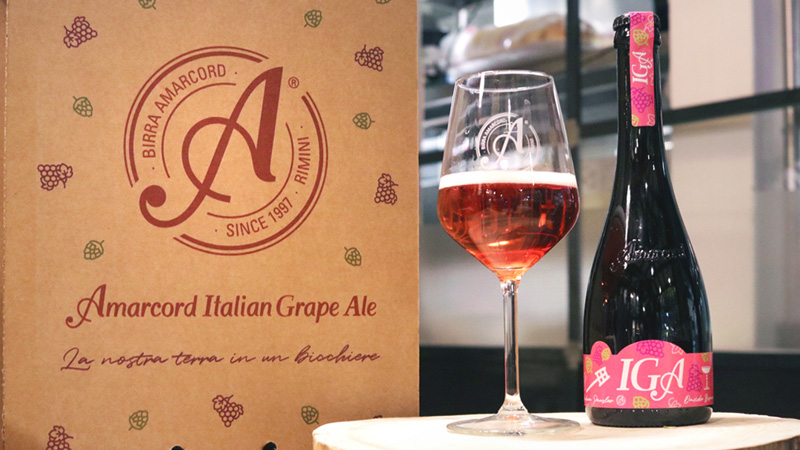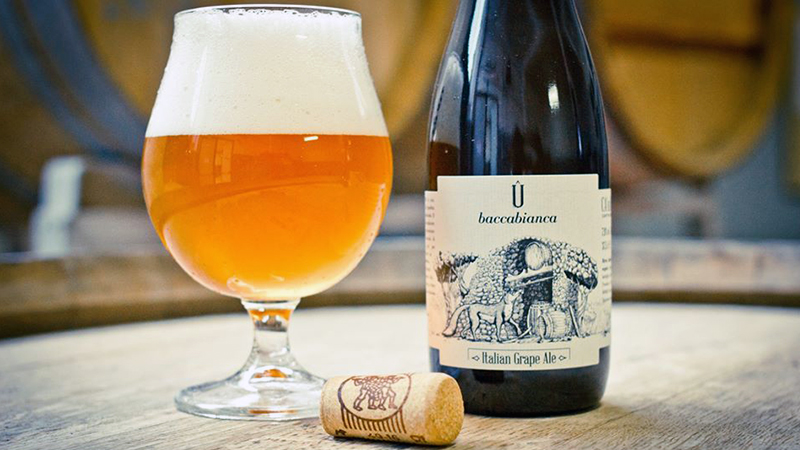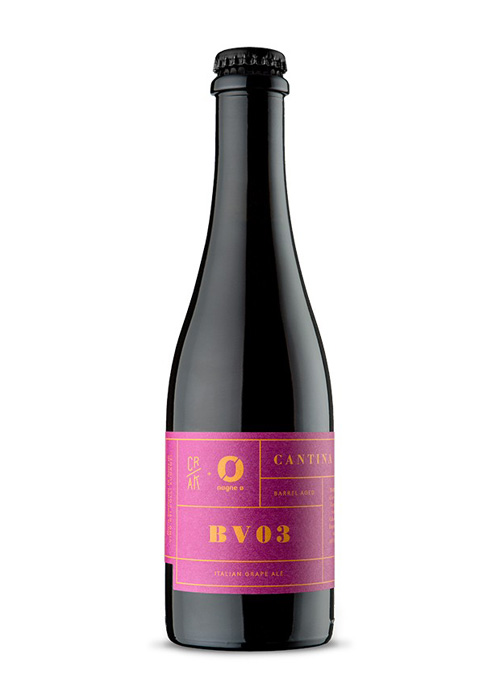In 2018, Liberati, an Italian restaurant and brewery co-founded by Alex Liberati, was one of Denver’s most anticipated openings of the year. Billing itself as the only brewery in the world to specialize in Italian grape ales, Liberati introduced its patrons to “oenobeers,” a term Liberati coined to describe “a beer-wine hybrid with each beer using a different wine grape in its fermentation.”
Liberati, who is originally from Rome, may have introduced oenobeers to Denver, but the concept of craft beers with wine grapes, known locally in Italy as Italian grape ales (IGAs), have existed for at least a decade. Italian craft brewers like LoverBeer, Birra Amarcord, Crak Brewery, and Cà del Brado are helping popularize the style with IGAs served at some of the world’s premier beer bars and bottle shops, from Brussels’ Moeder Lambic, to Paris’s La Fine Mousse, to Milan’s Lambiczoon.
These wine-inspired ales are not simply indications of an emerging trend, or Italian craft brewers’ focus on local ingredients (although both are true). More so, what IGAs represent are Italian craft brewers’ avid attempt to connect with their regions’ viticulture, and, through innovative brewing practices, bring more drinkers into the craft beer fold.
“Many Italian craft breweries have produced IGA in the last ten years being encouraged by the success of their craft beer and… passion for wine,” Monica Di Loxley, beer marketing and communications professional, certified beer sommelier, and author of The Italian Craft Beer blog, writes. These beers, previously overlooked even among beer lovers, are now receiving the attention they deserve.

The first to catch Di Loxley’s attention was Cà del Brado’s Û Baccabianca, an IGA brewed in Pianoro, Emilia-Romagna, Italy. The beer is spontaneously fermented with Grechetto Gentile grapes from Gradizzolo, a biodynamic winemaker also in the Emilia-Romagna region. The “skin contact” beer is barrel-aged for six months with Brettanomyces Lambicus, along with yeast from the the grapes’ own skin.
“This ‘speciality’ beer can be considered as an expression of the biodiversity, creativity, [and] connection with the local history and traditions where the brewery dug its roots, exactly as the vine does,” Di Loxley writes.

Although not yet recognized as an official beer style in the U.S., the Beer Judge Certification Program (BJCP) guidelines describe Italian grape ale as “a sometimes refreshing, sometimes more complex Italian ale characterized by different varieties of grapes.”
Depending on the grape and the brewer’s technique, everything from an IGA’s color, to its aroma, to its flavor and mouthfeel varies. Grapes are used as either full fruit or grape must; they can be incorporated at any stage in the brewing process, from the boil, to fermentation, to aging; and the result is likewise dependent on malt and hop varieties used. In other words, an IGA, though a “style” of its own, can taste like anything from a fruited sour ale to a barleywine, or even a hazy IPA. (Although, the BJCP notes, though “wild” character may be present, an IGA “should not be as intense” as a Belgian lambic.)
Crak Brewery, perhaps best known for its American-inspired DDH IPAs and brightly branded can collaborations, dipped a toe into Italian grape ale territory with Grape Soup, a collaboration with Barcelona’s Garage Beer. The IPA is double-dry-hopped with Citra and Mosaic hops, and also fermented with “a massive dose of yellow Muscat from our local wine area Colli Euganei,” the brewery website says.
Crak’s Cantina series, meanwhile, includes the more complex IGA Cabernet, aged 12 months in Chardonnay Borgogna barriques with grapes from Filò delle Vigne; and IGA Merlot, a sour wild Italian grape ale blend aged 12 months with grapes from Filò delle Vigne and cherries from Crak’s own property. Aging takes place 60 percent in Barolo barriques and 40 percent in Amarone barriques. Both brewery and vineyard are located in Italy’s Veneto region.

Of course, the concept of combining malt and grape is not new. Belgian landmark brewer Cantillion began experimenting with white grape lambic in the 1970s and has annually produced its Cantillon Vigneronne, an Italian white grape lambic, since the late 1980s.
Notable American beer-wine hybrids include Dogfish Head Craft Brewery’s Midas Touch, Captain Lawrence Brewing’s Cuvée de Castelton, and Two Roads Brewing’s Sauvignon Blanc Gose, the latter of which VinePair ranked among the best beers of 2018.
What makes Italian grape ales distinct is not their use of the vinous fruit, then, but the cultural context in which they are doing so. With a beverage culture focused on wine, and craft beer labels demanding more money as well as coming with more risk, catching consumers’ attention is a serious challenge for Italy’s artisanal brewers.
Italian grape ales, with their variety of vineyard-driven nuances, show a promising future as a cultural entity and entry point for those drinkers.
“Our aim is to see where we can go with this; to explore, discover and learn,” Liberati writes. “It’s a blank canvas and that’s exciting.”
